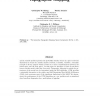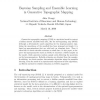PROCEDIA
2010
14 years 4 months ago
2010
Generative Topographic Mapping (GTM) is an important technique for dimension reduction which has been successfully applied to many fields. However the usual Expectation-Maximizat...
NECO
1998
14 years 5 months ago
1998
Latent variable models represent the probability density of data in a space of several dimensions in terms of a smaller number of latent, or hidden, variables. A familiar example ...
IJON
1998
14 years 5 months ago
1998
The Generative Topographic Mapping (GTM) model was introduced by 7) as a probabilistic re-formulation of the self-organizing map (SOM). It offers a number of advantages compared ...
IJCSS
2000
14 years 5 months ago
2000
The process of extracting knowledge from data involves the discovery of patterns of interest which may be implicit, for instance, in speci
NPL
2000
14 years 5 months ago
2000
Generative topographic mapping (GTM) is a statistical model to extract a hidden smooth manifold from data, like the self-organizing map (SOM). Although a deterministic search algo...
NN
2006
Springer
14 years 5 months ago
2006
Springer
The Generative Topographic Mapping (GTM) was originally conceived as a probabilistic alternative to the well-known, neural networkinspired, Self-Organizing Maps. The GTM can also ...
HPDC
2010
IEEE
14 years 7 months ago
2010
IEEE
Visualization of large-scale high dimensional data tool is highly valuable for scientific discovery in many fields. We present PubChemBrowse, a customized visualization tool for c...
CCGRID
2010
IEEE
14 years 7 months ago
2010
IEEE
Abstract--Large high dimension datasets are of growing importance in many fields and it is important to be able to visualize them for understanding the results of data mining appro...
IDEAL
2005
Springer
14 years 11 months ago
2005
Springer
The elastic net and related algorithms, such as generative topographic mapping, are key methods for discretized dimension-reduction problems. At their heart are priors that specify...


